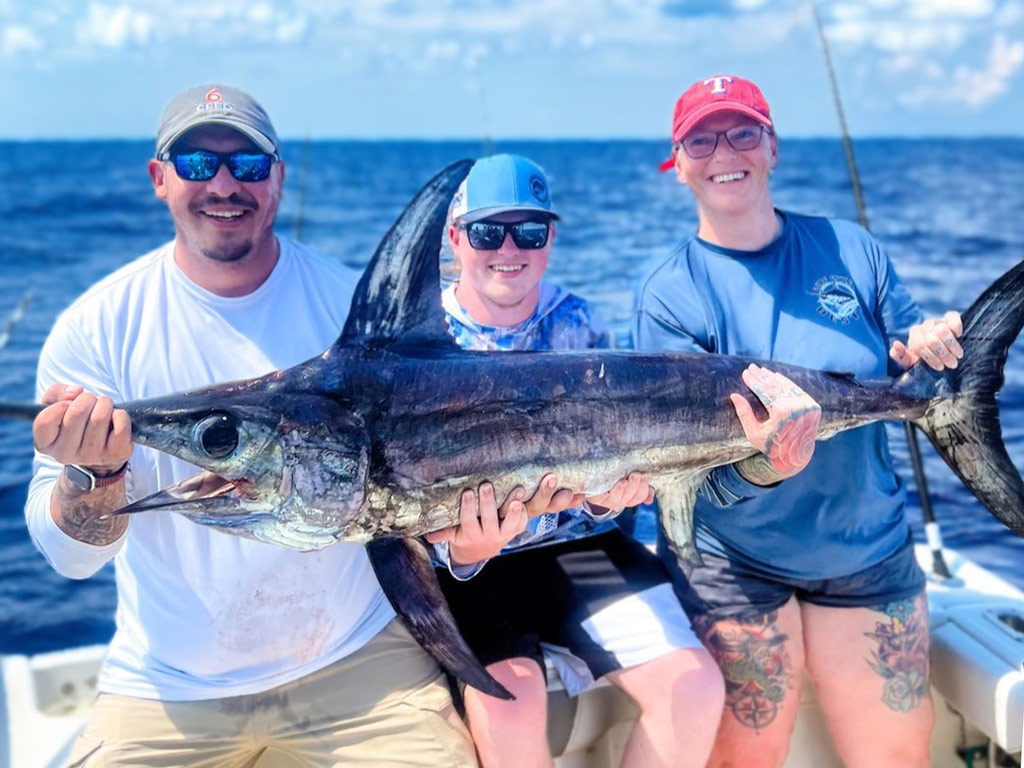Swordfish, with their extended, flat snouts and astonishing power, are one of the most coveted game fish in the ocean. With their long, slender shapes, muscular tails and deep-water haunts, they are both a fighting challenge and a blast for any angler. Whether an expert fisherman or a novice who is inquisitive, swordfish fishing has an endless world of excitement to explore and value to offer.
What is a Swordfish?
The swordfish (Xiphias gladius) is a wide-ranging, large predatory fish characterised by a long, flat bill. It grows to more than 1,000 pounds in size, but those caught by anglers weigh 100 to 300 pounds, typically. Swordfish are cosmopolitan animals and are found in all the world’s oceans in a wide range of water depths.
They are strong and fast-moving, and are usually found in deep offshore waters, making them one of the most difficult fish to catch.
Where to Find Swordfish?
Swordfish as a species reside in both the Atlantic and Pacific Oceans and are infamous for their vertical migrations. It means they are generally found in deep water during the day hours (pressure of around 1,500-2,000 feet down) and move to the surface when it’s time for dinner.
Popular swordfishing locations include:
Florida Keys
Gulf of Mexico
Caribbean Sea
South America’s east coast
Hawaii
California coast
Mediterranean Sea
Daytime vs. Nighttime Swordfishing
There are two main approaches to going after sheet metal: daytime deep dropping and nighttime drift fishing.
Daytime Swordfishing:
It entails fishing from very deep water (up to 2,000 feet) with electric or manual reels. Large lead weights (8 to 15 pounds) are employed to carry the bait to the bottom, where swordfish congregate during the day.
Pros: Better catch rates, big fish.
Cons: More technical, gear-heavy and fatiguing.
Nighttime Swordfishing:
At night, they rise closer to the surface to feed, prey on swordfish. It’s a tactic that involves trolling baits at a multitude of depths from 100–400ft.
Pros: Less stuff required, more chill time.
Cons: Fewer hookups, and fish are often smaller.
Essential Gear for Swordfish Fishing
Swordfishing requires serious, dedicated tackle owing to the fish’s strength and the depths at which they are found.
Recommended gear includes:
Rod and reel: Heavy-duty is best with an electric reel during the day, such as an LP S1200 or Hooker Electric reel. Use traditional reels like Shimano Tiagra 80 or Penn International for night fishing.
Braid/leader: 80 – 100 lb braided line with a 200 – 300 lb mono or fluoro leader.
Wind on leaders and ball bearing swivels for deep dropping.
Heavy drop weight: 8 to 15 pounds, depending on the current.
Lights: Swordfish also like light. You can use glow sticks or electric lights clipped to the line.
Hooks and bait: 10/0-12/0 circle hooks. They are commonly baited with squid, bonito belly, dolphin belly and mackerel.
Tips for Success
Provide the Correct Lighting: Swordfish are curious predators. Lights beside the bait make gingerbread with a high hit rate.
Mark the Bites: Note the precise depth of the bites, fish that zone.
Be Willing to Wait: Swordfishing often requires taking your time. So whatever you do, don’t give up after a few drifts.
And the rod: These fish will hit hard. Ensure your rod is well set up, and you’re open for a strong run.
Practice Hook Setting: For a solid hookup, let the swordfish chew a few seconds before adding any pressure.
Charter or DIY?
For those who are new to swordfishing, a charter trip can be the best plan. Charter captains are also bringing their experience, gear and local knowledge to the party, making sure you are successful.
When you’re comfortable and set up, consider taking some DIY trips with friends or mission-minded, experienced anglers.
Is Swordfish Good to Eat?
Absolutely! Table Swordfish is highly marketable. It has a firm texture and a mild, meaty flavour, ideal for grilling or baking. Just watch your mercury levels; the FDA recommends eating it in moderation, especially for pregnant women and children.
Conservation & Legal Guidelines
Swordfish stocks have since recovered with the help of strict regulations and fishing quotas. Be sure to always check your local laws regarding:
Bag limits
Minimum sizes
Required permits or tags
“By allowing the release of smaller or non-targeted swordfish, we can promote more robust populations of this species for the future.”
Conclusion
Fishing for swordfish isn’t a sport; it’s an adventure. Whether you fish hundred fathom grounds in the day or drift over tiles at night, a swordfish is the realisation of every angler’s dream. With enough preparation, some good gear and the right game plan, you can make that dream a reality.
FAQs About Swordfish Fishing
When is swordfish in season?
Swordfish are taken year-round in most areas, but the best fishing is usually found late spring through early fall when the seas are calmer and the fish are active.
Can beginners go swordfishing?
Yes, particularly if they have taken out a charter. Do-it-yourself swordfishing is best left to more seasoned anglers, as gear and tactics are both technical.
How deep are you fishing for swordfish during the day?
They were usually 1,200 to 2,000 feet deep, dropping heavily weighted lines to reach the sea floor.
What is the best bait to catch swordfish?
Squid is the most widespread and most effective bait, though dolphin belly, mackerel and bonito strips are good too.
How long do swordfish fights last?
That depends on the size of the fish and the type of tackle used. Brawls could last anywhere from half an hour to several hours.


